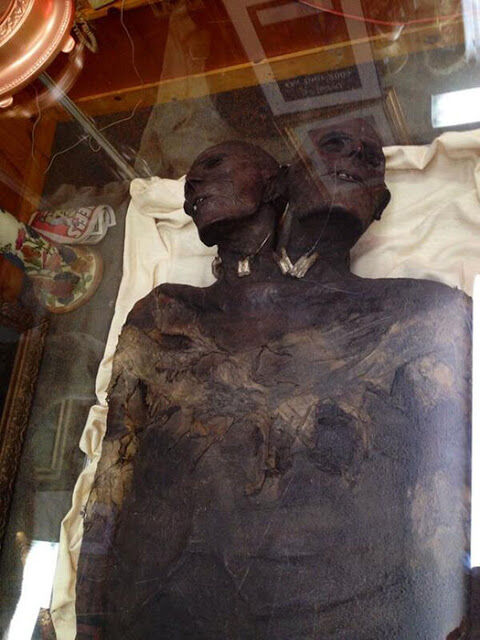A Two-Headed Giant has been discovered in Patagonia
Kap Dwa is a two-headed giant cryptid allegedly discovered by Spanish sailors off the coast of Argentina in the 17th century. The accounts of its capture vary, but afterwards, its mummified remains were brought to England, and in the 19th century if circulated between various circuses and sideshows.

The Kap Dwa is considered to be a hoax produced through taxidermy
Etymology
The name “Kap Dwa” literally means “Two Heads” in the language of the Malay people. It’s important to note that the Malay people are not from South America, where the cryptid was allegedly discovered.
The Malay are an Austronesian ethnic group found in modern-day Malaysia, Indonesia, Thailand, and Singapore. This incongruity with the cultural origin of the name of the creature and the location it was allegedly discovered may also indicate its hoax status.
Capture
There are two competing accounts for how this creature was allegedly captured. In one account, the Spanish sailors captured the creature alive.
The Spaniards lashed him to the mainmast, but he broke free (being a giant) and during the ensuing battle suffered a fatal injury; they skewered him through the chest with a pike.
In another account, the sailors merely discovered the body of the giant with a spear already puncturing its chest.
England and the United States
Record of what happened next to the dead body of the creature is unclear, but its mummified remains were eventually brought to England, where the remains entered the Edwardian Horror Circuit.
Over the years the remains passed from one showman to another. Eventually, in 1914, the Kap Dwa ended up displayed at the Birnbeck Pier, North Somerset England, where it would stay for forty-five years.
In 1959, the remains were purchased by an alleged lord by the name of Thomas Howard. From Howard, the remains passed again from owner to owner until arriving at its current location, Bob’s Side Show at Antique Man Ltd. in Baltimore, Maryland.
Similar Sightings
Sebalt de Weert (May 2, 1567 – May 30 or June 1603) was a Dutch captain associated with the exploration of the coasts of South America and the Falkland Islands south of Argentina.
De Weert and several crew claimed to have seen members of a “race of giants” while there. De Weert described a particular incident when he was with his men in boats rowing to an island in the Magellan Strait.
The Dutch claimed to have seen seven odd-looking boats approaching with were full of naked giants. These giants supposedly had long hair and reddish-brown skin and were aggressive towards the crew.
Medical Knowledge vs the Legend
For Kap Dwa to be genuine, we would have to suppose two very unlikely scenarios at once. We would have to presume that dicephalic parapagus twins were born who had yet another rare and lifespan-reducing disorder, gigantism, and they were somehow able to overcome all the health problems related to both conditions and become full-fledged adults that were strong and healthy enough to engage in combat with a band of sailors.
While this is not out of the question, it does make the story much more unlikely and in need of considerably more evidence.
The body was allegedly examined by physicians in the 1960s who said that it showed no obvious signs of being fake. No other experts appear to have examined the body either to determine if it is genuine or if it had the internal anatomic requirements to be likely to survive as a set of dicephalic parapagus twins.







